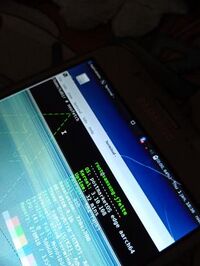Samsung Galaxy J7 (samsung-j7elte)
Appearance
OUTDATED! Since my development device became totally unusable for development purposes, this is why I'm leaving the postmarketOS development scene. It has been fun, but please if anybody has this device then please contribute on making the experience atleast more usable.. --KrakinTheKonsole
Samsung Galaxy J7 (codenamed j7elte) was a popular entry-level smartphone from 2015. It had many different iterations over the years and ports to postmarketOS has been made to them. This is my attempt on the original J7.
| This device runs a Downstream kernel. Some UIs will not work, and most features (3D acceleration, audio, etc.) may be broken. |
 This is a Image of a pretty badly destroyed Samsung Galaxy J7 running pmOS... | |
| Manufacturer | Samsung |
|---|---|
| Name | Galaxy J7 |
| Codename | samsung-j7elte |
| Released | 2015 |
| Type | handset |
| Hardware | |
| Chipset | Samsung Exynos 7580 Octa |
| CPU | 8x ARM Cortex-A53 @ 1500 MHz |
| GPU | ARM Mali-T720 MP2 @ 600 MHz |
| Display | 720x1280 SuperAMOLED |
| Storage | 16 GB |
| Memory | 1.5 GB LPDDR3 |
| Architecture | aarch64 |
| Software | |
Original software The software and version the device was shipped with. |
Android 5.1.1 |
Extended version The most recent supported version from the manufacturer. |
Android 6.1 |
| postmarketOS | |
| Category | downstream |
Mainline Instead of a Linux kernel fork, it is possible to run (Close to) Mainline. |
no |
pmOS kernel The kernel version that runs on the device's port. |
3.10.108 |
| Device package |
|
| Kernel package |
|
Flashing Whether it is possible to flash the device with pmbootstrap flasher. |
Partial
|
|---|---|
USB Networking After connecting the device with USB to your PC, you can connect to it via telnet (initramfs) or SSH (booted system). |
Works
|
Battery Whether charging and battery level reporting work. |
Partial
|
Screen Whether the display works; ideally with sleep mode and brightness control. |
Partial
|
Touchscreen |
Works
|
| Multimedia | |
3D Acceleration |
Untested
|
Audio Audio playback, microphone, headset and buttons. |
Partial
|
Camera |
Untested
|
| Connectivity | |
WiFi |
Untested
|
Bluetooth |
Untested
|
GPS |
Untested
|
| Modem | |
Calls |
Untested
|
SMS |
Untested
|
Mobile data |
Untested
|
| Miscellaneous | |
FDE Full disk encryption and unlocking with unl0kr. |
Untested
|
USB OTG USB On-The-Go or USB-C Role switching. |
Works
|
| Sensors | |
Accelerometer Handles automatic screen rotation in many interfaces. |
Untested
|
Magnetometer Sensor to measure the Earth's magnetism |
Untested
|
Ambient Light Measures the light level; used for automatic screen dimming in many interfaces. |
Untested
|
Proximity |
Untested
|
Hall Effect Measures magnetic fields; usually used as a flip cover sensor |
Untested
|
Barometer Sensor to measure air pressure |
Untested
|
Power Sensor Sensor to monitor current, voltage and power. Not fuel gauge! |
Untested
|
Contributors
Users owning this device
- Brunothedev
- Shadowsvanish (Notes: J700M variant, missing display)
Development status
Sources used
Lineage OS kernel sources for Exynos 7580 Devices
Compiles
- Linux kernel 3.10.108
- Device information
What's working
- Hardcoded kernel arguments
- Making a PMOS Recovery zip
- Flashing using custom recovery
- Showing splash screen during boot
- Starting full X-Session and using the UI with USB-OTG Keyboard and Mouse
- Running LXQt or SXMO
What's wrong
- When the phone boots it shows the splash screen meaning the rendering is working. But it crashes and force reboots soon after. - This is probably caused due to the fact that the init is messed up because the bootloader passes the wrong kernel arguments. The ones that are used to boot android. - But this issue has been fixed
- Being unable to mount the system partitions in TWRP to check logs or modify the system. - This is a common issue in many PMOS builds.
- Display manager not showing up after starting up
- WiFi and Bluetooth hardware not being detected or initialized.
- LightDM Failing to start properly. Causing it to not boot into desktop automatically
How to enter flash mode
Power down the device first.
ODIN/Heimdall Mode
To enter ODIN/Heimdall flashing mode, press and hold + + buttons until a warning screen pops up. Then press Volume Up button to enter ODIN mode.
Recovery (Stock/Custom) Mode
To enter Recovery (Stock/Custom) mode, press and hold + + buttons until the Recovery splash screen pops up.
Installation
Perform the standard installation method provided by PostMarket OS Installation Guide
But keep in mind that...
| WARNING: Installation with Heimdall partially works. It is recommended to use the custom recovery method provided by PMOS Wiki to install it. |
Remember to add these packages into the rootfs when asked in 'pmbootstrap init' :
|